Living with a still-growing personal collection of Gandhi artefacts for a decade has changed the way a Mumbai-based photographer and Goan painter approach Gandhian philosophy
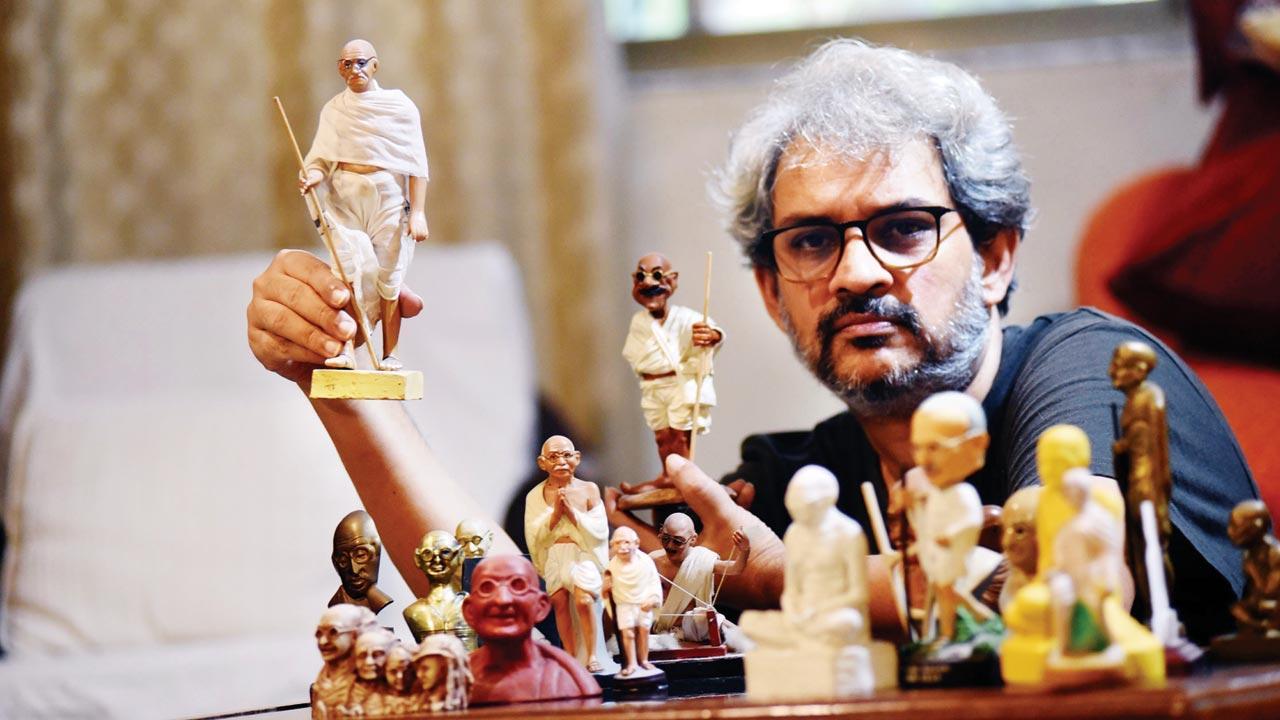
Photographer Chirodeep Chaudhuri, whose Mumbai home houses nearly 55 tiny figurines of Gandhi, began to collect 12 years ago, when he first picked up a plaster of Paris piece from a roadside vendor at Sonepur Mela in Bihar. Pic/Sameer Markande
Painter-sculptor Subodh Kerkar was only seven, when his father, also an artist, was commissioned by the Goa government to create a portrait of Mahatma Gandhi for the assembly. Kerkar’s family then lived in a Madgaon chawl, a row of housing settlements surrounded by coconut groves and fields. He vividly remembers his father bringing the painting out in the common verandah, after he had completed it. “He got all the kids in the neighbourhood to stand in front of the portrait, and asked us to fold our hands, and pray to him,” Kerkar tells us, over a video call. Thinking about it now, Kerkar, who is the founder of Museum of Goa, wonders if any of the modern-day leaders would elicit such veneration. “I don’t think so,” he feels. Over the years, he continued to engage with Gandhi and his teachings through his autobiography and other related texts. “I wasn’t a Gandhian,” he admits, “Gandhi is not easy to understand or follow. He was a very complex person.”
ADVERTISEMENT
 Subodh Kerkar
Subodh Kerkar
The last eight years, however, drew him closer to the Mahatma. “Right-wing politics had left me disturbed. I was feeling angry because it seemed that the whole idea of India was being demolished, and Gandhi was being appropriated by its leaders. That’s when I started reading Gandhi again, and more seriously. And I must tell you that Gandhi helped me get rid of the hatred and anger. Today, while I still oppose right-wing politicians, I don’t hate them. I still see some divinity in them, and feel they will improve. I am a changed man. This is the greatest gift Gandhi has given to me.”
 A poster from Kerkar’s collection, where Gandhi is shown as Jesus Christ and Bharat Mata as Mother Mary. Pics courtesy/Subodh Kerkar
A poster from Kerkar’s collection, where Gandhi is shown as Jesus Christ and Bharat Mata as Mother Mary. Pics courtesy/Subodh Kerkar
Around the time that this personal transformation was taking place, an artistic curiosity was also being spurred. Kerkar became a collector and creator of Gandhian works. Today, he has nearly 300 prints of posters and artworks, themed around the leader, and thrice the number in his digital archive, which includes photographs of rare Gandhian artefacts and memorabilia from around the world. “At one point, Gandhi was the biggest brand. Companies from all over the world were also creating something related to Gandhi, because of his market value. In the 1930s, a French company created a salt and pepper shaker with Gandhi painted on it. No other leader may have had so many posters of himself, as Gandhi did,” says Kerkar, quipping, “In fact, posters of him are being made ‘until yesterday’.”
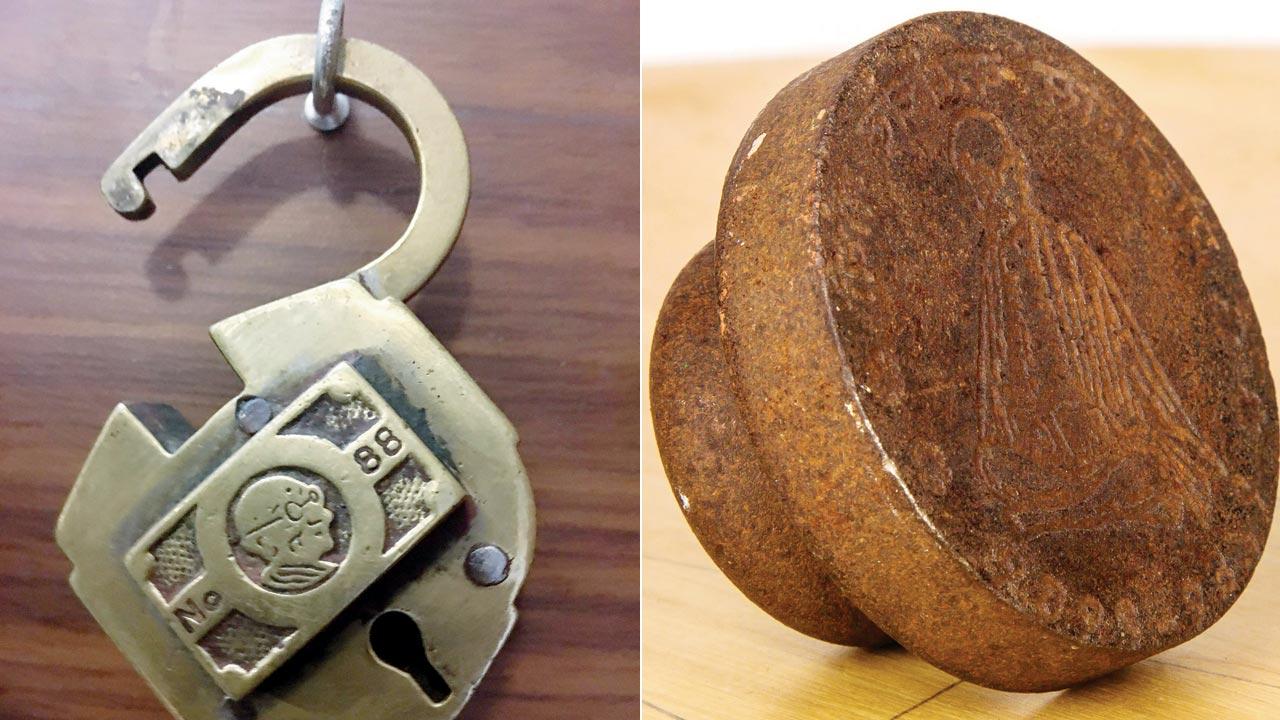 A photograph of a lock, which has Gandhi’s face embossed on it; (right) Another picture that Kerkar owns is that of a weight with Gandhi’s etching on it. This is symbolic of Gandhi’s teachings. He believed that every word should be weighed before it is uttered, says the veteran painter. “So though, he may have been inconsistent in thought, he never denied his statements”
A photograph of a lock, which has Gandhi’s face embossed on it; (right) Another picture that Kerkar owns is that of a weight with Gandhi’s etching on it. This is symbolic of Gandhi’s teachings. He believed that every word should be weighed before it is uttered, says the veteran painter. “So though, he may have been inconsistent in thought, he never denied his statements”
Sometime back, Kerkar came across a photograph of a lock, which had Gandhi’s face embossed on it. He was most curious about the artefact—a picture of which is now part of his collection—because he says Gandhi was an open book, a man of no secrets. That’s also how he lived. “Gandhi never ever used a lock. None of his houses had one.” Another picture he has is that of a weight with Gandhi’s etching on it. “I found it interesting because Gandhi was very careful about his weight. He weighed himself every week, and didn’t eat an ounce more than required.” But this weight also became symbolic of his teachings. He believed that every word should be weighed before it is uttered, says the veteran painter. “So though, he may have been inconsistent in thought, he never denied his statements.”
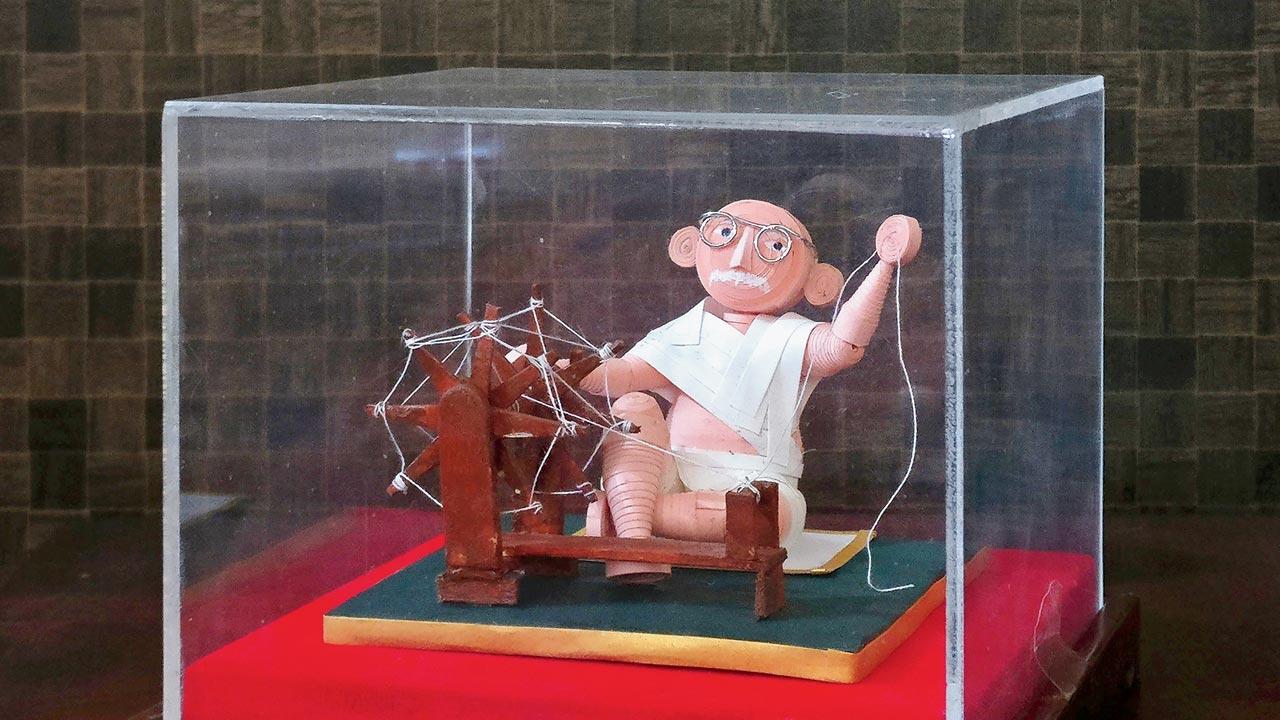 A Gandhi made using the technique of paper quilling by Sachin Salunkhe
A Gandhi made using the technique of paper quilling by Sachin Salunkhe
There’s little doubt that Kerkar is in awe of Gandhi. He has an ammo of anecdotes, which have either been shared with him or he has read about, in the recent past. Many artists also felt a similar reverence for Gandhi, often associating him with gods. “I have a poster where Gandhi is shown as Jesus Christ and Bharat Mata as Mother Mary,” he shares. Inspired by such a comparison, Kerkar created a portrait of Gandhi only with thorns, harking back to the image of Christ on the cross. “Another poster [I have] has Gandhi as Lord Ram, the British as Ravana, and Jawaharlal Nehru as Hanuman.” The hope is to showcase this collection and also his other Gandhi-inspired art at a museum, dedicated to the leader in Goa.
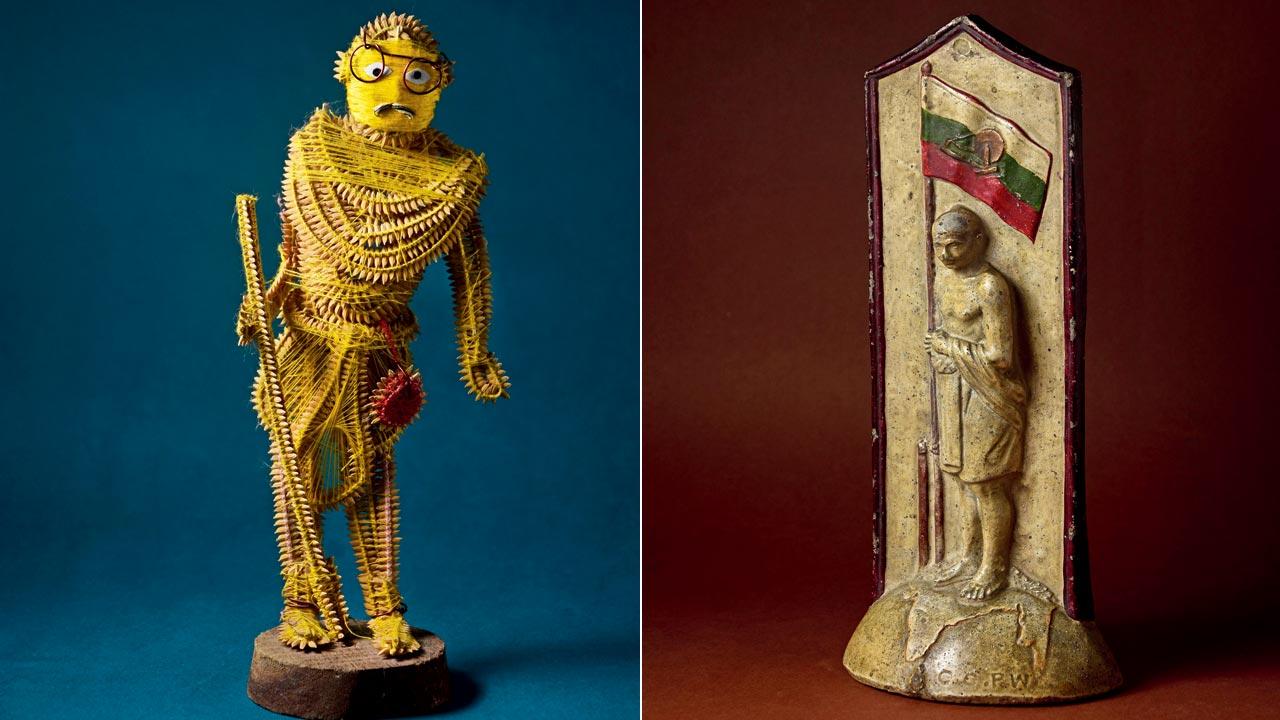 A Gandhi made of Bamboo filament, grain and sewing thread by Harekrushna Nayak from Kotpad, Orissa. Pics courtesy/Chirodeep Chaudhuri; (right) An undated pre-independence vintage that Chaudhuri’s aunt lent him for his collection. The clue is in the flag (Indian National Congress) and the map on the globe of an undivided India
A Gandhi made of Bamboo filament, grain and sewing thread by Harekrushna Nayak from Kotpad, Orissa. Pics courtesy/Chirodeep Chaudhuri; (right) An undated pre-independence vintage that Chaudhuri’s aunt lent him for his collection. The clue is in the flag (Indian National Congress) and the map on the globe of an undivided India
The painter’s friend, historian Vinay Lal, who teaches in the US, is one of the many people, helping him build on his collection of posters. “He shares all his work with me, and I, with him, because at the end of the day, Gandhi needs to be shared.”

A 3D-printed Yoda-inspired Gandhi designed by an artist in the USA
For Mumbai-based photographer Chirodeep Chaudhuri, a pursuit can last a lifetime. His earlier project, where he documented 81 public clocks from across the city for an exhibition in pre-pandemic 2020, took him 23 years to complete—but friends and colleagues will tell you that he’s still looking for them.
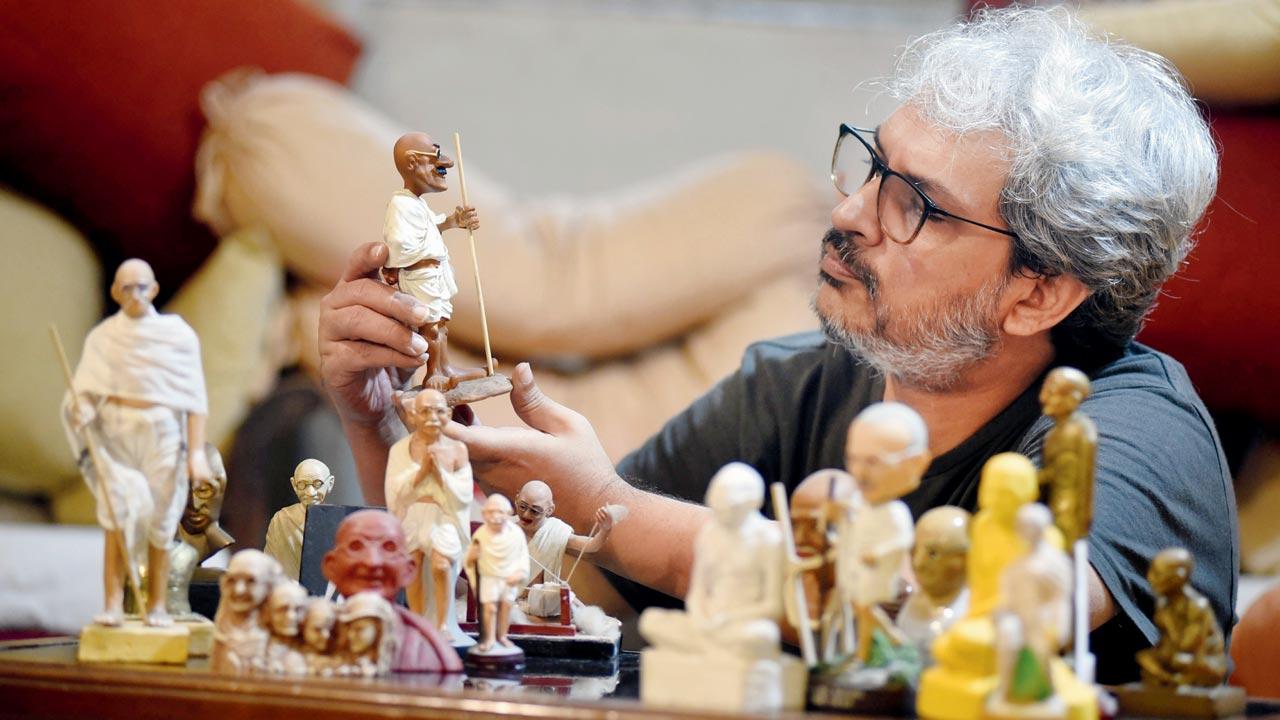 Chirodeep Chaudhuri has figurines of Gandhi made using clay, wood, brass, plastic, paper, aluminium, mother of pearl, plaster of Paris, ceramic, sandalwood, resin, wire, glass and chalk. Pic/Sameer Markande
Chirodeep Chaudhuri has figurines of Gandhi made using clay, wood, brass, plastic, paper, aluminium, mother of pearl, plaster of Paris, ceramic, sandalwood, resin, wire, glass and chalk. Pic/Sameer Markande
Chaudhuri’s search for Gandhi figurines also appears to have taken a similar route. While he had been reading “assorted texts” related to Gandhi, which also prompted him to take pictures of statues during his photo journalism assignments across India, it was only in 2009, while attending the Sonepur Mela in Bihar that he picked up his first Gandhi statue. “There is a part of the journey at the mela, when they stop vehicular traffic, and you have to walk. We were walking, when we stopped to buy water. On the roadside, a man was selling clay and plaster of Paris knick-knacks. In the middle of all these items, was a seated figurine of Gandhi. It caught my attention, and I immediately decided to buy it,” he recalls, adding, “Jerry [Pinto, author], who was travelling with me then, laughed saying, ‘Oh God! Now one more thing in your weird home’. I don’t quite know what provoked me to buy it.” However, later in the interview, he does remember seeing figurines of political leaders, including that of Gandhi, in his friend, journalist Naresh Fernandes’ home, which he says inspired him to start his own. But, it would be some time before he took it seriously.
The Gandhi piece from the mela had been lying in his home for a couple of years—“all alone” as he puts it—until Chaudhuri found another piece to give it company. “Krishnanagar, which is a town not very far from Kolkata, is known for its clay dolls and idols. I remember buying [Subhash Chandra] Bose and Gandhi from one of the curio shops here. At some point, I gave the Bose away, but the Gandhi stayed. Now that I had two, I thought why not build on this collection.” That’s really when the seed for Chaudhuri’s obsession with Gandhi was sown.
Today, he has nearly 55 tiny figurines of the Mahatma. “The size of these pieces are only important, because I live in a Bombay flat, where one is always running out of space,” he shares, adding, “But, my interest has always been in the smaller things. It narrows the collection down in an interesting way. Smaller objects with fine details that may not exactly be beautiful, but illustrate a certain kind of oddness.”
Chaudhuri sources his pieces from everywhere—state emporiums, craftsmen, village haats, online stores, and even friends and acquaintances, willing to generously part with their Gandhis. The variety of material used to make them is also diverse; there’s clay, wood, brass, plastic, paper, aluminium, mother of pearl, plaster of Paris, ceramic, sandalwood, resin, wire, glass and chalk. “What fascinates me is the different kinds of imaginations that people have, when it comes to representing Gandhi,” he says. Take, for instance, the 3D-printed ‘Yoda’ Gandhi, designed by an artist in the USA, or the Mt Rushmore-inspired piece with Gandhi, Sardar Patel, Bose and Bhagat Singh.
He has also got artists to imagine Gandhi for him. In September 2017, when travelling to Kotpad, Odisha, he met the late Harekrushna Nayak, who created a Gandhi out of bamboo filaments, wheat grain and coloured strings. He also reached out to quilling artist Sachin Salunkhe, asking if he would make Gandhi working on his charkha. Salunkhe, however, informed him that given the peculiarity of the material and technique, a sitting pose would be a challenge. He not only created Gandhi on a charkha, but also one of him standing with his lathi, both just as good. “My sense is that as the collection grows, some pieces that may be more obvious or standard, may go out. This is a very natural process in collecting.”
Chaudhuri hasn’t restricted his collection to figurines, alone. He has a Gandhi ball-point pen, a biker ring purchased on eBay, and even, a key holder, among other things. “That Gandhi is still so relevant for people to keep reimagining him, has been a revelation for me. I don’t know how long this would continue, given the circumstances and political climate that we are living in. Five years later, would there be enough Gandhi statues in India? Who knows?”
Virtual Gandhi
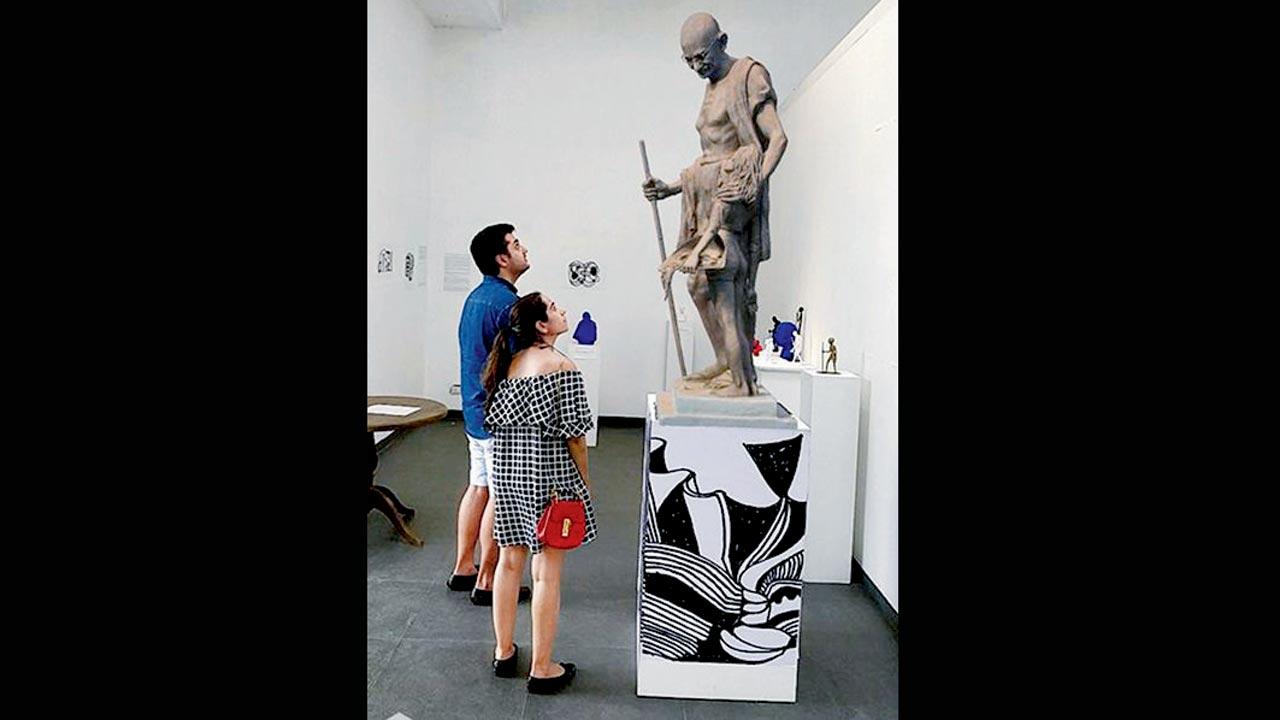
Some years ago, Subodh Kerkar, along with a 3D expert from Ukraine, travelled across the country documenting important Gandhi sculptures. “We shot thousands of images of each sculpture from all angles. These images were fed into a computer programme, which converted them into 3D images. We then developed an app, AHIMSA, which can be downloaded for free on Google Play Store.” At the Museum of Goa, the team created podiums, which are actually codes for the VR Gandhi sculptures. “The visitors can open the app, point the phones towards the podium and view the sculptures from all sides.”
 Subscribe today by clicking the link and stay updated with the latest news!" Click here!
Subscribe today by clicking the link and stay updated with the latest news!" Click here!







